- Joined
- Feb 5, 2015
- Messages
- 662
I posted this a few weeks ago but in the wrong sub-forum (Accessories rather than Shop Made Tooling) so I'm moving it here.
I’ve been looking at some shop-made rotary broaching tools for about a year, thinking that one could be very handy when a small internal feature is (occasionally) required. Finally I decided to make one and the result is shown below with the tool installed in a vertical mill.
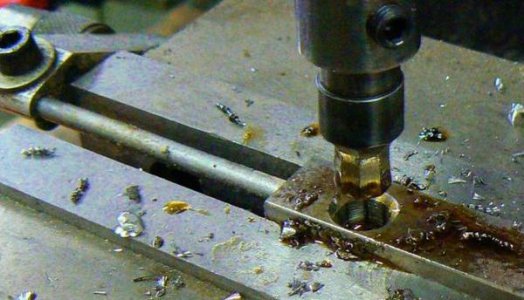
Most shop-made rotary broaches that I’ve seen use a pair of radial ball bearings and a ball thrust bearing. Most of these tools are also pretty darned large and would look ridiculous on my 8 x 30 vertical mill (and definitely overkill for my needs).
I made the compact design shown above by using a single hardened ball for both alignment and thrust. The ball thrust bearing runs in wheel bearing grease. The body of the tool is made from drill rod, torch-hardened moderately. (I would have used pre-hardened 4140 if I’d thought of it.)
The broaching tool was also made from drill rod but is harder than the tool holder. This is the second one made; the first was ruined while torch-hardening the finish machined part. The second one was turned to the finish diameters but only rough milled to the cutting shape.
After hardening and tempering, I used a solid carbide end mill to carefully bring the broach cutting surfaces to finish dimension (I have no surface grinder). Before using the tool I put it in the mill and gently lowered the rotating tool against a hard Arkansas oil stone to polish the face.
I didn’t make a radiused face like most of the other shop-made broaches found on the internet. This was intentional due to comments written by a guy (not sure of his position - manufacturing engineer, foreman, production machinist ?) who worked for Volkswagen for a number of years and was associated with their rotary broaching operations.
He wrote that, not only was the “dished” cutting face unnecessary but that it diminished the time between sharpenings because the sharper edges broke down and the breakage, although not visible, was easily seen under magnification as cratering and erosion of the cutting edge.
This is important because the cutting tool is tapered ! Any sharpening of the face reduces the dimensions of the finished work. I decided to give his opinion a try. I figured I can always carefully “dish” the face later if it didn’t work properly, right ? This is the result of the first test drive.
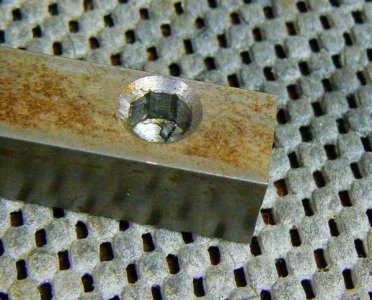
The hole in the workpiece is octagonal, .340 inches across the flats .500 deep and the workpiece is .750 square CRS material. I made the pilot hole .005 oversize then countersunk generously to provide a good start for the broach. The broach was run at 1000 RPM (just because) using black pipe threading oil.
It is visible in the photo that the feed was erratic. I might try using the boring crank rather than the quill lever next time as well as experimenting with spindle speed. Total broaching time was on the order of ten seconds.
The shape and dimensions of the prototype broach were arbitrary, determined by whim. More practical applications include producing hex holes, square holes and splined holes.
It seems like this tool will be handy. I can quickly make up custom broaches from 0.500 or 0.750 drill rod as the need arises. (I don’t envision producing an internal feature larger than 0.375.) For my purposes, heat treatment is not at all critical so a torch and some motor oil will suffice. I doubt that any broach that I make will be required to produce more than 10-20 parts.
Here is the complete tool; the house key gives an indication of tool size …
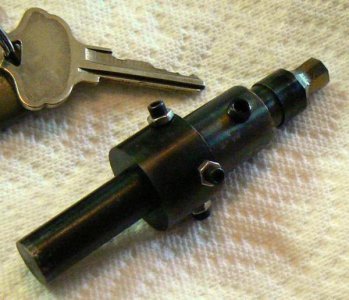
Works in the lathe too, of course:
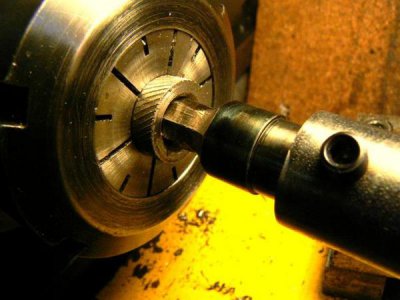
And here’s a sketch:
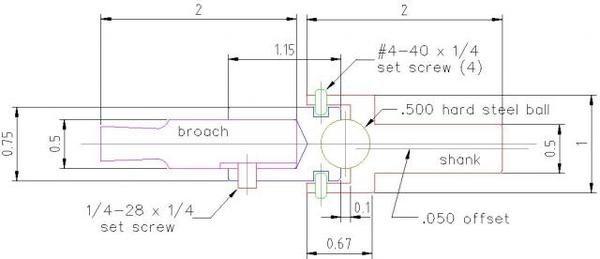
There are four #4-40 screws around the perimeter of the shank. During operation, they ride in a clearance groove and don't contact anything. Their purpose is to prevent the two parts of the tool and the steel ball from separating when not in use.
This is a photo of the disassembled tool. There are only two machined parts - not including the broach itself,
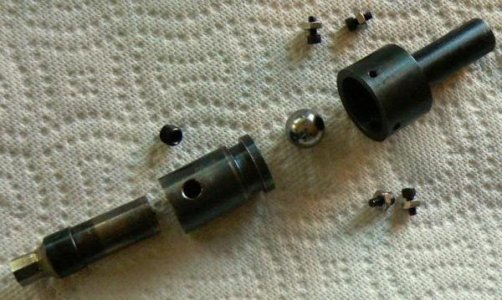
edited to add the disassembled photo
I’ve been looking at some shop-made rotary broaching tools for about a year, thinking that one could be very handy when a small internal feature is (occasionally) required. Finally I decided to make one and the result is shown below with the tool installed in a vertical mill.

Most shop-made rotary broaches that I’ve seen use a pair of radial ball bearings and a ball thrust bearing. Most of these tools are also pretty darned large and would look ridiculous on my 8 x 30 vertical mill (and definitely overkill for my needs).
I made the compact design shown above by using a single hardened ball for both alignment and thrust. The ball thrust bearing runs in wheel bearing grease. The body of the tool is made from drill rod, torch-hardened moderately. (I would have used pre-hardened 4140 if I’d thought of it.)
The broaching tool was also made from drill rod but is harder than the tool holder. This is the second one made; the first was ruined while torch-hardening the finish machined part. The second one was turned to the finish diameters but only rough milled to the cutting shape.
After hardening and tempering, I used a solid carbide end mill to carefully bring the broach cutting surfaces to finish dimension (I have no surface grinder). Before using the tool I put it in the mill and gently lowered the rotating tool against a hard Arkansas oil stone to polish the face.
I didn’t make a radiused face like most of the other shop-made broaches found on the internet. This was intentional due to comments written by a guy (not sure of his position - manufacturing engineer, foreman, production machinist ?) who worked for Volkswagen for a number of years and was associated with their rotary broaching operations.
He wrote that, not only was the “dished” cutting face unnecessary but that it diminished the time between sharpenings because the sharper edges broke down and the breakage, although not visible, was easily seen under magnification as cratering and erosion of the cutting edge.
This is important because the cutting tool is tapered ! Any sharpening of the face reduces the dimensions of the finished work. I decided to give his opinion a try. I figured I can always carefully “dish” the face later if it didn’t work properly, right ? This is the result of the first test drive.

The hole in the workpiece is octagonal, .340 inches across the flats .500 deep and the workpiece is .750 square CRS material. I made the pilot hole .005 oversize then countersunk generously to provide a good start for the broach. The broach was run at 1000 RPM (just because) using black pipe threading oil.
It is visible in the photo that the feed was erratic. I might try using the boring crank rather than the quill lever next time as well as experimenting with spindle speed. Total broaching time was on the order of ten seconds.
The shape and dimensions of the prototype broach were arbitrary, determined by whim. More practical applications include producing hex holes, square holes and splined holes.
It seems like this tool will be handy. I can quickly make up custom broaches from 0.500 or 0.750 drill rod as the need arises. (I don’t envision producing an internal feature larger than 0.375.) For my purposes, heat treatment is not at all critical so a torch and some motor oil will suffice. I doubt that any broach that I make will be required to produce more than 10-20 parts.
Here is the complete tool; the house key gives an indication of tool size …

Works in the lathe too, of course:

And here’s a sketch:

There are four #4-40 screws around the perimeter of the shank. During operation, they ride in a clearance groove and don't contact anything. Their purpose is to prevent the two parts of the tool and the steel ball from separating when not in use.
This is a photo of the disassembled tool. There are only two machined parts - not including the broach itself,

edited to add the disassembled photo
Last edited:

